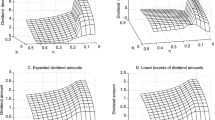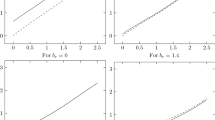Abstract
We consider an optimal dividend and capital structure problem for a firm, which holds a certain amount of debt to which is associated a financial ratio covenant between the firm and its creditors. We study optimal policies under a bankruptcy framework, using a mixed reduced and structural approach in modeling default and liquidation times. Once in default, the firm is given a grace period during which it may inject more capital to correct the situation. The firm is liquidated if, by the end of the grace period, assets do not exceed the debt. Under this setup, we maximize the discounted amount of dividends distributed minus the capital injected up to the time of liquidation. It gives rise to a two-dimensional singular control problem leading to a non-standard system of variational inequalities. Beyond the usual viscosity characterization, we completely solve this problem and obtain a description of the continuation, dividend and capital injection regions enabling us to fully characterize the optimal policies. We conclude the paper with numerical results and illustrations.




Similar content being viewed by others
Notes
Although it may not make sense for a financial point of view, we allow the initial duration \(\varXi _0\) to take any value less than \(\delta \) to take advantage of time homogeneity and to simplify the dynamic programming principle.
References
Merton, R.C.: On the pricing of corporate debt: the risk structure of interest rates. J. Finance 29, 449–70 (1974)
Black, F., Cox, J.C.: Valuing corporate securities: some effects of bond indenture provisions. J. Finance 31, 351–367 (1976)
Jeanblanc, M., Shiryaev, A.: Optimization of the flow of dividends. Russ. Math. Surv. 50, 257–277 (1995)
Asmussen, S., Taksar, M.: Controlled diffusion models for optimal dividend pay-out. Insur. Math. Econ. 20, 1–15 (1997)
Choulli, T., Taksar, M., Zhou, X.Y.: A diffusion model for optimal dividend distribution for a company with constraints on risk control. SIAM J. Control Optim. 41, 1946–1979 (2003)
Choulli, T., Taksar, M., Zhou, X.Y.: Interplay between dividend rate and business constraints for a financial corporation. Ann. Appl. Probab. 14, 1810–1837 (2004)
Sethi, S.P., Taksar, M.I.: Optimal financing of a corporation subject to random returns. Math. Finance 12, 155–172 (2002)
Décamps, J.P., Villeneuve, S.: Optimal dividend policy and growth option. Finance Stoch. 11(1), 3–27 (2007)
Ly Vath, V., Pham, H., Villeneuve, S.: Mixed singular/switching control problem for a dividend policy with reversible technology investment. Ann. Appl. Probab. 18, 1164–1200 (2008)
Jin, Z., Yin, G., Zhu, C.: Numerical solutions of optimal risk control and dividend optimization policies under a generalized singular control formulation. Automatica 48(8), 1489–1501 (2012)
Chevalier, E., Gaigi, M., Ly Vath, V.: Liquidity risk and optimal dividend/investment strategies. Math. Financ. Econ. 11(1), 111–135 (2017)
Chevalier, E., Ly Vath, V., Scotti, S.: An optimal dividend and investment control problem under debt constraints. SIAM J. Financ. Math. 4, 297–326 (2013)
Pierre, E., Villeneuve, S., Warin, X.: Liquidity management with decreasing-returns- to-scale and secured credit line. Finance Stoch. 20(4), 809–854 (2016)
Lokka, A., Zervos, M.: Optimal dividend and issuance of equity policies in the presence of proportional costs. Insur. Math. Econ. 42, 954–961 (2008)
Décamps, J.-P., Mariotti, T., Rochet, J.-C., Villeneuve, S.: Free cash flow, issuance costs, and stock prices. J. Finance 66–5, 1501–1544 (2011)
Jin, Z., Yang, H., Yin, G.: Numerical methods for optimal dividend payment and investment strategies of regime-switching jump diffusion models with capital injections. Automatica 49, 2317–2329 (2013)
Jin, Z., Yin, G.: An optimal dividend policy with delayed capital injections. ANZIAM J. 55, 129–150 (2013)
Keppo, J., Peura, S.: Optimal bank capital with costly recapitalization. J. Bus. 79(4), 2163–2201 (2006)
Bolton, P., Chen, H., Wang, N.: Market timing, investment, and risk management. J. Financ. Econ. 109, 40–62 (2013)
Hugonnier, J., Malamud, S., Morellec, E.: Capital supply uncertainty, cash holdings and investment. Rev. Financ. Stud. 28, 391–445 (2015)
Makarov, R.N., Metzler, A., Ni, Z.: Modelling default risk with occupation times. Finance Res. Lett. 13, 54–65 (2015)
Yildirim, Y.: Modeling default risk: a new structural approach. Finance Res. Lett. 3, 165–172 (2006)
Broadie, M., Chernov, M., Sundaresan, S.: Optimal debt and equity values in the presence of Chapter 7 and Chapter 11. J. Finance 62(3), 1341–1377 (2007)
Kushner, H., Dupuis, P.G.: Numerical Methods for Stochastic Control Problems in Continuous Time. Stochastic Modelling and Applied Probability, vol. 24, 2nd edn. Springer, New York (2013)
Budhiraja, A., Ross, K.: Convergent numerical scheme for singular stochastic control with state constraints in a portfolio selection problem. SIAM J. Control Optim. 45(6), 2169–2206 (2007)
Acknowledgements
This research was supported by the Natural Sciences and Engineering Research Council of Canada.
Author information
Authors and Affiliations
Corresponding author
Additional information
Communicated by Lars Grüne.
Publisher's Note
Springer Nature remains neutral with regard to jurisdictional claims in published maps and institutional affiliations.
Appendix: Proof of Theorem 3.1
Appendix: Proof of Theorem 3.1
Proof
Equations 19 and (20) follow from Proposition 2.2. The proof of the supersolution property is classical, so we omit it and focus on the subsolution property.
Let \((\varsigma ,x,y) \in \mathring{\mathcal S}^1\times \mathring{{\mathcal {S}}}^0\). Let \(\psi _0 \in C^{2}(\mathring{{\mathcal {S}}}^0)\) and \(\psi _1 \in C^{1,2}(\mathring{{\mathcal {S}}}^1)\) such that \(\psi _1(\varsigma ,x) = v_1(\varsigma ,x)\), \(\psi _0(y)=v_0(y)\) and \(\psi _i \ge v_i,\) \(i=0,1.\) We have to prove that \((\psi _0,\psi _1)\) satisfies (15)–(18) with \(=\) replaced by \(\ge .\) Suppose that it is not true:
Case (1) Assume that inequality associated with (16) is not satisfied.
There exists \(\eta >0\) such that
Since \(\psi _1 \in C^{1,2}(\mathring{{\mathcal {S}}}^1)\), we can assume that there exists \(\epsilon >0\) (\(\epsilon <\min (x,D-x,\varsigma ,\delta -\varsigma )\)) such that the above inequality is also satisfied for all (s, z) such that \(|x-z|^2 + |s-\varsigma | \le \epsilon .\)
Let \((Z,K) \in {\mathcal {A}}\). Then, if we set \( \theta := \inf \{t \ge 0 : |X^x_t - x |^2 + \varXi _t - \varsigma > \epsilon \}\), we have \(|X_\theta -x |^2 - \epsilon + \theta \ge 0.\) Furthermore, \(\theta < T\wedge \theta ^{D,+}\) and \(|X_t-x|^2 + \varXi _t-\varsigma \le \epsilon \) for all \(t\le \theta .\) Notice that on \([0,\theta ]\), \(d\varXi _t= dt\) then, by Itô’s formula, we get
It follows from (47) that
Consequently, we get
Combining the previous inequality with the fact that \(\psi _1 \ge v_1\) and (47), we get
Let \(\varphi (s,z) = C ((z-x)^2-\epsilon + (s-\varsigma )),\) for some positive constant \( C < \min ( \frac{1}{2 \sqrt{\epsilon }}, \frac{1}{\rho \epsilon + 2 {\bar{\mu }} \sqrt{\epsilon } + {\bar{\sigma }}^2 + 1})\) in which \({\bar{\mu }} = \sup _{x\in [0,D]} \mu (x), {\bar{\sigma }} = \sup _{x\in [0,D]} \sigma (x).\)
By Itô’s formula,
Taking a supremum over \((Z,K) \in {\mathcal {A}}\) in (48) and applying the dynamic programming principle (11), we find the following contradiction: \(v_1(t,x) \ge v_1(t,x) + \eta C \epsilon .\)
Case (2) Assume that inequality coming from (17) is not verified for some \((\varsigma ,0) \in [0,\delta ]\times \{0\}\): There exists \(\eta \) and \(t >0\) such that for all \(\epsilon >0\), \(0\le x \le \epsilon \), and \(\varsigma \le s \le \varsigma +t \)
due to the continuity of \(v_1\) and \(\frac{\partial \psi _1}{\partial x}.\) Here, \(C = \sup _{\varsigma \le s \le \varsigma +t} \frac{\partial \psi _1(s,0)}{\partial s}.\) Assume further that \(\epsilon < \min (D, v_1(\varsigma ,0)/\eta )\) and \(t < \delta - \varsigma \).
We consider \(\theta :=\inf \{s\ge 0: X_s\ge \varepsilon \}\) and deduce from (49) and the dynamic programming principle (11) that
where \(A_0 = \sup _{0\le x \le \epsilon } v_1(\varXi _t,x)\), a finite quantity, and \(J_1\) stands for \(\int _0^{\theta \wedge T \wedge t} {\mathrm{e}}^{- \rho s} {\mathrm{d}} K_s\). We can therefore bound the value \(v_1(\varsigma ,0)\) above by
where \(C' = \sup _{x< D} \left( \frac{\mu (x) - \rho x}{1-\kappa _1}\right) < \infty \) and Burkholder–Davis–Gundy inequality has been applied. Finally, if we simplify by \(v_1(\varsigma ,0)\) and divide by \(\varepsilon \), we get \(\eta \le \frac{\epsilon (C+C'+ A_0/t)}{\underline{\sigma }^2}\). We find a contradiction by sending \(\epsilon \) to 0.
The inequality coming from (15) is proved with a line of reasoning similar to Case (1) and (18) by a proof similar to Case (2). \(\square \)
Rights and permissions
About this article
Cite this article
Chevalier, E., Ly Vath, V. & Roch, A. Optimal Dividend and Capital Structure with Debt Covenants. J Optim Theory Appl 187, 535–565 (2020). https://doi.org/10.1007/s10957-020-01760-4
Received:
Accepted:
Published:
Issue Date:
DOI: https://doi.org/10.1007/s10957-020-01760-4
Keywords
- Viscosity solutions
- System of variational inequalities
- Singular controls
- Optimal stopping
- Bankruptcy
- Debt covenants




